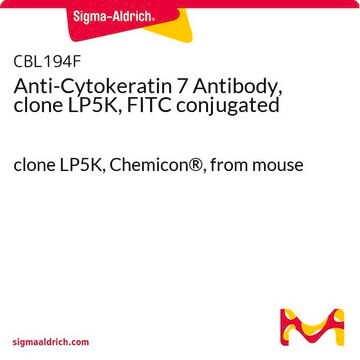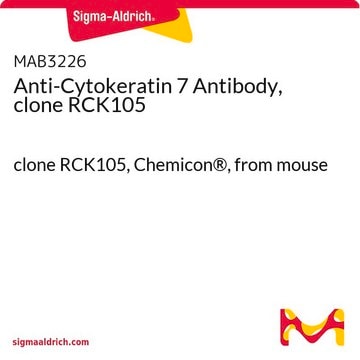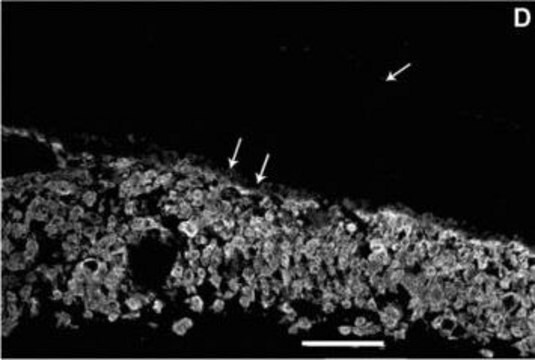MAB3554
Anti-Cytokeratin 7 Antibody, clone OV-TL 12/30
clone OV-TL 12/30, Chemicon®, from mouse
Sinónimos:
Anti-Anti-CD20, Anti-Anti-CK-20, Anti-Anti-CK20, Anti-Anti-K20, Anti-Anti-KRT21
Seleccione un Tamaño
671,00 €
Seleccione un Tamaño
About This Item
671,00 €
Productos recomendados
origen biológico
mouse
Nivel de calidad
forma del anticuerpo
purified antibody
tipo de anticuerpo
primary antibodies
clon
OV-TL 12/30, monoclonal
reactividad de especies
human
fabricante / nombre comercial
Chemicon®
técnicas
flow cytometry: suitable
immunocytochemistry: suitable
immunohistochemistry: suitable (paraffin)
western blot: suitable
isotipo
IgG1
Nº de acceso NCBI
Nº de acceso UniProt
Condiciones de envío
dry ice
modificación del objetivo postraduccional
unmodified
Información sobre el gen
human ... KRT7(3855)
Descripción general
Especificidad
Inmunógeno
Aplicación
Immunohistochemistry on frozen tissue sections fixed with methanol. The antibody is also effective on paraffin embedded tissue sections that have been pretreated with 0.1% pronase/0.1% trypsin in PBS, 0.5% pepsin in 0.01N HCl or microwave pretreatment.
Optimal working dilutions must be determined by the end user.
Cell Structure
Cytokeratins
Ligadura / enlace
Forma física
Almacenamiento y estabilidad
Otras notas
Información legal
Cláusula de descargo de responsabilidad
¿No encuentra el producto adecuado?
Pruebe nuestro Herramienta de selección de productos.
Código de clase de almacenamiento
12 - Non Combustible Liquids
Clase de riesgo para el agua (WGK)
WGK 2
Punto de inflamabilidad (°F)
Not applicable
Punto de inflamabilidad (°C)
Not applicable
Certificados de análisis (COA)
Busque Certificados de análisis (COA) introduciendo el número de lote del producto. Los números de lote se encuentran en la etiqueta del producto después de las palabras «Lot» o «Batch»
¿Ya tiene este producto?
Encuentre la documentación para los productos que ha comprado recientemente en la Biblioteca de documentos.
Filtros activos
Nuestro equipo de científicos tiene experiencia en todas las áreas de investigación: Ciencias de la vida, Ciencia de los materiales, Síntesis química, Cromatografía, Analítica y muchas otras.
Póngase en contacto con el Servicio técnico








